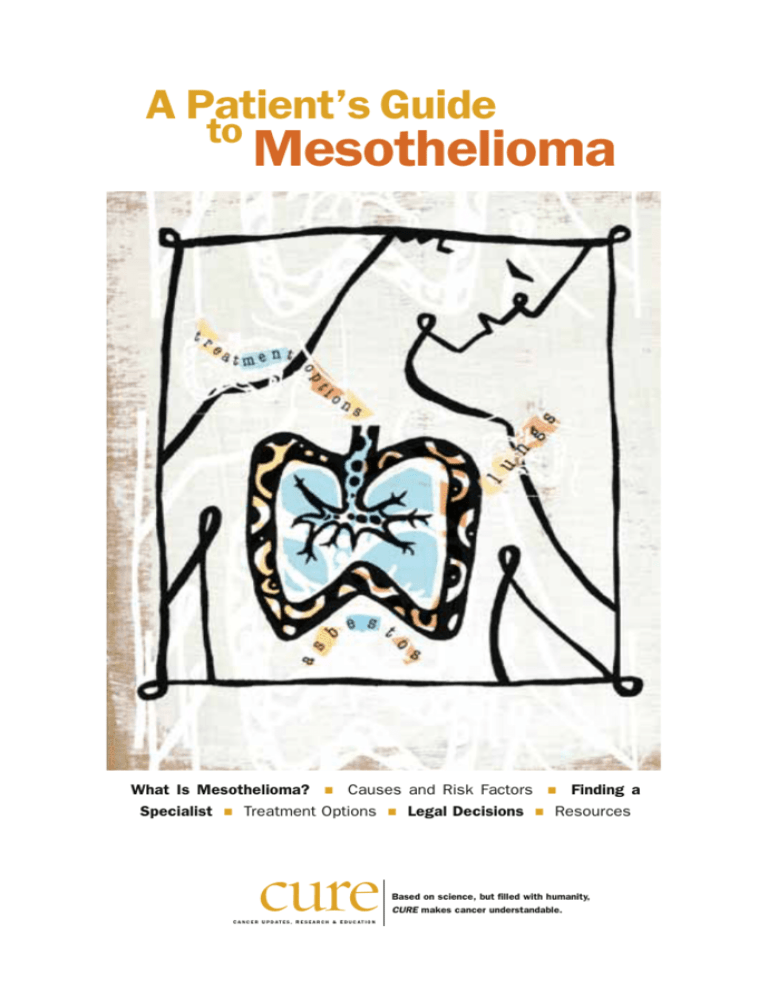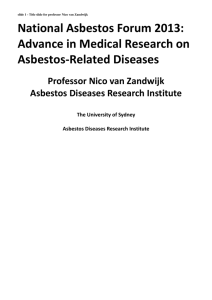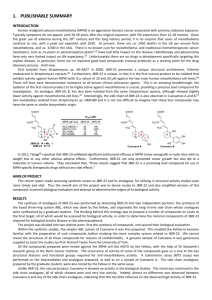
A Patient’s Guide
to
Mesothelioma
What Is Mesothelioma?
Specialist
n
n
Causes and Risk Factors
Treatment Options
cure
C a n c e r U p d a t e s , R e s e a r c h & E duc a t i o n
n
Legal Decisions
n
n
Finding a
Resources
Based on science, but filled with humanity,
CURE makes cancer understandable.
A Patient’s Guide
to Mesothelioma
Mesothelioma is a rare cancer, with 2,000 to 3,000 new cases
diagnosed each year, and understanding the disease is impor tant in
making decisions about care and treatment.
mesothelioma forms in the mesothelium,
a protective membrane covering internal
organs, such as the lungs and heart. The
mesothelium is made up of two layers—one
surrounding the organ itself and the other
forming an outer sac. Between the layers is a
lubricating fluid that lessens friction between
the membranes and permits the organs to
glide smoothly against each other. This is
particularly important to the heart and lungs,
because they produce significant movement
as they function.
Mesothelioma is defined by the site of
the primary tumor. Pleural mesothelioma, in
which cancer cells surround the lungs and/or
the chest wall, accounts for about 85 percent
of malignant mesotheliomas. Mesothelioma
can also grow across the thin mesothelial
tissue that lines the abdomen (peritoneum)
or, rarely, the heart or testicles.
Mesothelioma is different from other
cancers because it’s tightly linked with an
environmental cause—asbestos exposure,
which accounts for the majority of cases.
Most mesothelioma patients worked or
lived in a place where they were exposed
to asbestos. Typical mesothelioma patients
worked in shipyards or as miners and are
men age 60 and older, but family members
of these workers have also developed the
disease—many with relatively little direct
exposure. Also, because mesothelioma can
take decades to develop, most patients are
older at diagnosis.
The geographic distribution of this disease
is not uniform across the United States,
with the highest death rates appearing in
the Northeastern states, along the Pacific
Coast, and in Illinois, Florida, Wyoming, and
Colorado. As with the demographic imbalance,
the geographic distribution can also be
explained by asbestos exposure—the regions
with the highest death rates are (or were)
home to either factories that manufactured
asbestos-containing products or shipbuilding
facilities (asbestos materials were commonly
used as insulation in ships).
Although the average patient survives only
four to 18 months after diagnosis, and only
10 percent of patients survive at least five
years, there have been reports of long-term
survivors who have no evidence of disease
many years following treatment.
Causes & Risk Factors
Asbestos exposure is the most common
cause of mesothelioma. The term “asbestos”
actually refers to several minerals with shared
properties: long, flexible fibers that are
resistant to stretching, heat, and corrosion. It’s
because of these properties that asbestos was
used in products such as insulation, roofing,
floor and ceiling tiles, and brake pads.
Though the asbestos industry launched in
the late 1800s, scientists didn’t link the
mineral to mesothelioma until the 1950s. In
the United States, asbestos continued to be
mined and used—particularly for insulation—
until the 1980s.
Of the various types of asbestos, the fibers
most commonly used in the United States are
chrysotile (white asbestos), crocidolite (blue
asbestos), and amosite (brown asbestos).
Chrysotile is most widely used because its
fibers are curled, a property that makes it
less likely to fragment than the other types of
asbestos. Crocidolite and amosite are typically
used in limited, specialized applications
because their needle-like structure makes
them highly susceptible to fragmenting. This
is important because if asbestos is easily
crushed, it remains airborne longer, which
increases the likelihood of inhaling the fibers
that cause mesothelioma.
Generally, it takes 20 to 40 years or
more for mesothelioma to develop following
asbestos exposure. The exact means by which
asbestos causes cancer has not yet been fully
determined, but it is known when asbestos
is inhaled, about two-thirds of the fibers are
eliminated from the body by coughing or
swallowing. The remaining fibers travel through
the airways, and some may reach the alveoli,
the tiny air sacs in the lungs. Although the
method by which asbestos fibers arrive at the
mesothelium is not certain, it is likely that this
journey takes years, a belief that fits with the
extended period of time necessary to develop
mesothelioma.
It has never been established if there
are any “safe” levels of asbestos exposure.
However, there is at least circumstantial
evidence that even low environmental levels
of asbestos exposure can increase the risk
of mesothelioma.
Interestingly, smoking is not a risk factor
for mesothelioma. However, smoking does
increase the risk of lung cancer, which is
frequent in people with asbestos exposure.
Thus, people with both a history of smoking
and asbestos exposure have an elevated risk
of developing lung cancer—approximately
60-fold higher than nonsmokers with no
asbestos exposure.
While asbestos is the most common
cause of mesothelioma, certain
characteristics of the disease suggest that
asbestos exposure is not the only cause.
Other suspects include:
Simian Virus 40
Due to conflicting research, perhaps the
most controversial link to mesothelioma is
exposure to simian virus 40 (SV40), a virus
that contaminated polio vaccines during the
1950s and 1960s. In the ’50s, monkeys were
used to develop a vaccine against polio, but in
1961, it was discovered that these monkeys
were infected with SV40, which meant the polio
vaccines were likely contaminated. Shortly
thereafter, animal studies showed that SV40
was capable of causing cancer, producing
significant alarm regarding the cancer-causing
potential of the contaminated polio vaccines.
Who’s at Risk?
Cancer patients often wonder why they got
the disease. Most cases of mesothelioma
involve asbestos exposure, but you may be
unsure when, or even how, your exposure
Some research supports the possibility
that SV40 and asbestos may work together
to cause mesothelioma. For instance, cells
with chromosomal abnormalities (such as
those caused by asbestos exposure) can
gain cancer-like characteristics more easily
when infected with SV40 compared to cells
with normal chromosomes.
occurred. Although minute levels of asbestos
exist in the air, water, and soil, most people
do not develop mesothelioma from this type
of exposure. People who develop the disease
generally have regular asbestos exposure,
such as from a job.
In the 1970s, legislation was enacted to
protect workers from asbestos exposure, but
Erionite
Erionite is a non-asbestos mineral fiber
that is similar in physical characteristics to
crocidolite. Erionite has been identified as
a cause of mesothelioma based on studies
of mesothelioma rates among residents of
Cappadocia, Turkey, where erionite has been
used in building materials. Of 141 deaths
in four villages during a four-year period, 24
percent were due to mesothelioma. Erionite
deposits can be found throughout the western
United States, primarily in areas with a low
population density. To date, however, there have
been no cases of mesothelioma attributed to
erionite exposure in the United States.
Genetic Predisposition
Further examination of the link between
erionite exposure in Turkey and the high
mesothelioma death rate produced evidence
that genetic predisposition might also be
a factor in development of the disease.
Although all homes in that region contained
similar amounts of erionite, mesothelioma
occurred in some homes and not in others.
In addition, mesothelioma development
followed a dominant genetic inheritance
pattern, in which half of the children of
parents with mesothelioma also developed
mesothelioma. This pattern is consistent
with a single genetic mutation from one
prior to that, workers in certain industries may
have had regular exposure to asbestos. Some
of these occupations are:
n
Insulation work in buildings and other
structures
n
Demolition work, especially in older
buildings
n
Drywall workers
n
Firefighters
n
Automobile mechanics
n
Steel mill workers
n
Shipyard and shipbuilding trades
n
Navy veterans
Family members of asbestos-exposed
workers may develop mesothelioma because
of regular exposure to the fibers brought home
on clothing, shoes, and hair. Regular exposure
may have occurred from tasks such as washing
work clothes that contained asbestos fibers.
of the parents causing the disease. While
these observations cannot be considered
conclusive evidence for a genetic
predisposition to mesothelioma, they do
provide reason to further study the role of
genetics as a risk factor.
Diagnosis & Staging
Diagnosing mesothelioma can be a
complicated process. Symptoms do not
typically arise until the disease has reached
the late stages, and when they do arise, most
are nonspecific, including weight loss, fatigue,
and night sweats.
Depending on the type of mesothelioma,
organ-specific symptoms may be present.
For instance, most patients with pleural
mesothelioma experience lung-related
symptoms, such as consistent chest pain
and progressively worsening shortness
of breath. The pain is typically caused by
invasion of cancer into the chest wall, and
shortness of breath is often caused by
pleural effusion (excess fluid in the pleural
linings of the lungs). The presence of cough,
or coughing up blood, can occasionally occur
with pleural mesothelioma.
Proper diagnosis requires a combination
of physical, radiological, and pathological
examinations, as well as an accurate
patient history, including potential asbestos
exposure.
For patients with pleural effusions, a
sample of the fluid is examined for the
presence of malignant cells. In most cases,
even when a pleural fluid sample is available,
a biopsy of the pleural tissue is required to
make a diagnosis. Examination of the biopsy
samples includes immunohistochemistry (IHC)
tests, in which the samples are processed
in a way that allows the pathologist to
look for specific signs, called markers, of
mesothelioma. There are no known markers
that correspond to mesothelioma alone,
so in order to diagnose mesothelioma, the
pathologist generally evaluates the presence
or absence of several markers.
Radiological analysis using contrastenhanced computed tomography (CT)
scan provides a three-dimensional view
of the entire pleural surface. It can help
determine the extent of disease and can aid
the physician in finding the desired tissue
for biopsy. Magnetic resonance imaging
(MRI) and positron emission tomography
(PET) scans may also be used to diagnose
mesothelioma.
Once the diagnosis is made, the disease
stage is evaluated. As with any type of
cancer, determining the extent of the disease
is used to predict a patient’s outcome and to
determine the best course of treatment.
In stage 1, the disease is confined to
the mesothelium and has not spread to the
lymph nodes or any other organs. Stage 1A
refers to a tumor in the outer layer of the
mesothelium, whereas stage 1B refers to a
tumor that has reached both the outer and
inner layer. Stage 1 is the most treatable,
and patients with this stage disease have the
best prognosis (expected outcome).
Stage 2 disease is characterized by the
spread of cancer beyond the mesothelium
and into the lung tissue and/or diaphragm,
but not yet into the lymph nodes. Patients
with stage 2 mesothelioma may be
candidates for surgical removal of the tumor.
For stage 3 mesothelioma, the cancer has
spread into the fatty part of the mediastinum
(the space behind the breastbone and
between the lungs) and/or to the lymph
nodes within the thorax.
Stage 4 is metastatic disease, where the
cancer has spread to other organs, such as
the heart or opposite lung. The cancer may
also have spread into the peritoneum, to the
lymph nodes, or into the spine.
Questions to Ask
Finding a
Specialist
Because mesothelioma is a rare cancer,
it requires disease-specific expertise.
Here are some places you can go to find a
mesothelioma specialist:
Local hospital referral services
Your nearest National Cancer Institutedesignated cancer center (search by state at
www.cancer.gov/cancertopics/factsheet/NCI/
cancer-centers)
n American Board of Medical Specialties at
www.abms.org
n American Medical Association’s
DoctorFinder at webapps.ama-assn.org/
doctorfinder/home.jsp
n American Society of Clinical Oncology’s
patient site at www.cancer.net
n American College of Surgeons at
www.facs.org/patienteducation
n Mesothelioma Applied Research
Foundation at www.marf.org
n
n
Once you have found several doctors
who seem like a good fit, call and ask a
few questions—does the doctor take your
insurance, is he or she board certified—
before scheduling an appointment to meet
and interview the doctor/surgeon.
You may also want to get a second
opinion. Most oncologists expect their
patients to seek second opinions, and many
suggest it themselves. If your doctor doesn’t
recommend a specialist, you can use the
resources listed to find a doctor who can
offer a second opinion.
Nurse coordinators at large medical
centers can be particularly helpful in finding
physicians who give second opinions.
Support groups and other cancer survivors
may also be good sources for recommending
Prepare for your appointment by formulating
a list of questions to ask. You may want to
divide questions into two categories:
What to Ask the Doctor
n Do you have experience treating
mesothelioma?
n How long have you been in practice, and
how many cases of mesothelioma have you
treated?
n What types of treatment do you usually
recommend?
n How many times have you performed the
surgery I need, and what’s your success
rate?
n Are you involved in clinical trials and
research?
n Who else will be on my health care team,
and what are their qualifications?
What to Ask Yourself
Did the doctor give you a chance to ask
questions?
n Did you feel like the doctor was listening to
you?
n Did the doctor seem comfortable
answering your questions?
n Did the doctor talk to you in a way you
could understand?
n Do you feel the doctor respected you?
n Did the doctor ask your preferences for
treatment?
n
oncologists and specialists. Keep in mind
that these consultations can be expensive
and may not be covered by insurance.
For some insurance plans, second
opinions are covered or even required before
the plan approves payment for treatment, but
you may be limited to certain physicians or
hospitals.
After you weigh your options, you must
choose your medical team. The comfort level,
treatment options proposed, and medical
expertise should all be evaluated when
making a decision.
Treatment Options
Improvements in treatment have been
made in recent years, giving mesothelioma
patients hope. An overview of current and
investigational therapies are detailed here.
Surgery
Although complete surgical removal of the
tumor is desired, this is rarely achievable for
most patients because microscopic tumor
tissue is generally left behind. However,
surgery is still used to treat patients with the
goal of removing the vast bulk of the tumor
and thus alleviating symptoms. The surgical
procedures include:
Video-assisted thoracoscopic (VATS) talc
pleurodesis is primarily used to treat pleural
effusions, but a biopsy can be obtained at the
same time for diagnostic purposes. With VATS
talc pleurodesis, a camera is inserted into the
pleura through a small incision in the chest,
and surgical instruments are inserted through
two other incisions. The camera allows the
surgeon to maneuver instruments into the
pleural space, where the surgeon first drains
the excess fluid and then blows talc (similar
to common talcum powder, but sterilized),
causing an inflammatory reaction that literally
glues the lung to the inner surface of the rib
cage. Eventually, scar tissue forms, creating
permanent bonds that eliminate the space
in which fluid can develop. This procedure
should relieve the shortness of breath that
accompanies pleural effusions.
n
Pleurectomy/decortication (P/D) is
performed with the goal of removing as much
of the tumor as possible by removing part of
the pleura as well as the fibrous covering of
the lungs, which may restrict lung expansion.
n
This procedure, which can be performed by
VATS or through a larger incision on the side
of the chest, is associated with a number
of postoperative complications, including air
leak, bleeding, and pus formation. Conflicting
evidence exists regarding the impact of P/D,
with some studies suggesting it prolongs life
and others indicating it does not.
Extrapleural pneumonectomy (EPP),
the most aggressive surgical treatment
for malignant mesothelioma, involves the
removal of both layers of the pleura along
with the involved lung, some of the lymph
nodes, the diaphragm, and the pericardium
(the latter two are reconstructed with
synthetic materials). Although EPP has
inherent dangers, it permits the use of
radiation therapy following surgery since the
involved lung has been removed. Evidence
suggests radiation after surgery may reduce
recurrence at the original tumor site and
prolong survival in patients with earlystage disease. Chemotherapy is now often
incorporated into the treatment plan as
well, either before or after surgery. However,
because of the morbidity and mortality
associated with this procedure, EPP is only
performed on patients with early-stage
disease, good cardiac health, no history
of certain cardiac or lung surgeries, no
significant kidney or liver disease, and little,
if any, chest pain.
n
Radiation Therapy
Radiation therapy is generally used to treat
localized patches of tumor recurrence
or small areas of tumor left behind after
surgery. There is no evidence to suggest
radiation alone improves survival, but it does
alleviate pain for approximately half of the
patients receiving it.
Chemotherapy
The goals of current chemotherapy regimens
are to prolong the survival of mesothelioma
patients and improve their quality of life by
relieving disease-related symptoms.
The approval of Alimta (pemetrexed) in
2004 has led to the largest improvement in
patient outcomes. When added to cisplatin,
Alimta, which works by inhibiting cellular
proteins that stimulate cancerous cells to
grow, was shown in a clinical study to prolong
average survival by almost three months.
Alimta also relieved pain and shortness
of breath, and improved lung function in
some patients. Alimta plus cisplatin given
intravenously once every three weeks has
become standard therapy for newly diagnosed
mesothelioma. (Clinical studies of Tomudex
[raltitrexed], a drug in the same class as
Alimta, have also shown improved response
rates and survival times when given with
cisplatin compared with cisplatin alone.)
Premedication with folic acid and vitamin
B12 is necessary when taking Alimta in
order to reduce the frequency of side effects,
which can include fatigue, nausea, vomiting,
anorexia (loss of appetite), constipation,
mouth sores, and low blood cell counts. More
severe side effects, including renal failure and
hearing loss, occur in rare instances.
Investigational Therapies
A number of important mesothelioma
studies were presented at the 2009 annual
meeting of the American Society of Clinical
Oncology. A phase III trial comparing
Adriamycin (doxorubicin) with or without the
experimental drug Onconase (ranpirnase),
showed the average survival of both groups
was nearly identical: 10.7 months for the
Onconase group versus 11.1 months for
patients receiving Adriamycin alone. However,
when investigators looked only at patients
who had already received one course of
chemotherapy, they found that those patients
survived longer, on average, when Onconase
was added to treatment: 10.5 months for
the Onconase group versus nine months for
patients receiving Adriamycin alone.
Also presented at ASCO’s annual meeting
were results from studies with the targeted
agents cediranib and NGR-hTNF, both of
which target the tumor’s blood supply.
Cediranib and NGR-hTNF were examined
as single agents, and both demonstrated
the ability to slow disease progression in
patients with relapsed mesothelioma. As a
result of these findings, new clinical trials are
being planned.
An ongoing phase III trial is investigating
Zolinza (vorinostat), which is already
approved for a rare type of lymphoma, to
see if it improves survival of patients with
mesothelioma. In this trial, patients whose
disease progressed after treatment with
Alimta will be given either Zolinza or placebo.
New treatments in phase II development
include drugs approved by the Food and Drug
Administration for other cancers—Sprycel
(dasatinib), Velcade (bortezomib), Sutent
(sunitinib), Afinitor (everolimus), and Eloxatin
(oxaliplatin)—as well as investigational
drugs that are not approved (pazopanib,
vandetanib, and vatalanib).
Find ongoing mesothelioma clinical trials at
www.curetoday.com/trialcheck.
Legal Issues
Companies involved in the manufacture
and distribution of products containing asbestos
can be held liable for the development of
mesothelioma in workers exposed to asbestos.
Statutes of limitations vary from state
to state and may limit the time in which
you can file a lawsuit after diagnosis. The
limitation period can be as short as one
year or as long as three years or more, but
the sooner you start the legal process, the
sooner you will receive compensation to help
with medical bills and other expenses. Your
case may be expedited depending on your
symptoms and the stage of the disease.
The most common types of lawsuits include:
n Personal injury: These lawsuits are filed
for personal suffering and pain associated
with the illness, which can occur from direct
or secondhand exposure to asbestos.
Compensation is based on the degree of
incapacity, loss of income, and quality of
life related to mesothelioma symptoms and
treatment. Damages are awarded for medical
expenses, lost wages, lost prospects, travel
expenses for treatment, pain, and suffering.
n Wrongful death: This type of lawsuit
is filed on behalf of the family after the
patient’s death. The damages awarded are
for payment of mesothelioma-related medical
bills, lost income, counseling related to the
patient’s death, legal advice, personal loss,
and other illness-related services.
Choosing an attorney is a personal
decision, just as when choosing a medical
team. You should feel comfortable with the
answers you receive to your questions, the
way you are treated by the attorney and
staff, the level of experience and positive
outcomes the law firm has had with other
mesothelioma and asbestos-related cases,
and the firm’s reputation. A word of caution:
An attorney should never promise you a
specific amount of compensation. There are
no guarantees; each case is unique.
Legal advice and the process of filing
a lawsuit is an expensive undertaking.
Most attorneys accept a case based on a
contingency fee, meaning you will have no
out-of-pocket expenses and the attorney will
receive a percentage of your settlement money
as payment. The contingency fee pays for legal
work done on your behalf, court filing fees,
expert witness fees, and legal representation
in court. If an award is not granted, you may
be responsible for some expenses depending
on the contingency fee agreement.
Once you decide to hire an attorney, you
will meet with the legal staff to provide
information about your work history and
personal history to determine the type and
degree of asbestos exposure you sustained.
Authorizations will be obtained to get copies
of your medical records, and you should not
have to undergo any further medical testing
for the purposes of the lawsuit.
Next, you will be asked to give a deposition
(getting your testimony on tape) in case
you are not able to appear in court. Some
attorneys also have a videographer follow
you for a day to document what a typical day
with mesothelioma is like for you. This can be
shown in court to support your case.
Many patients worry that with a lengthy
litigation process, they may die before the
case is settled. If you pass away, your loved
ones can continue to litigate in your place
if you have designated an executor of your
estate and beneficiaries in your will.
Preparing for
End of Life
End of life care focuses on patients’
start by asking the following questions:
comfort and symptom relief, while incorporating
n
spiritual and psychological counseling to help
you live?
prepare for a good death.
n
Preparing for death also involves drawing up
legal documents, such as a health care power
of attorney and living will. With a health care
power of attorney, you will want to choose a
person to make medical decisions and initiate
your care plan when you are no longer able
to speak for yourself. Sometimes close family
members are not able to separate emotions
from logic and may have difficulty carrying
out your wishes, so discuss your wishes with
your appointee to verify his/her cooperation
and comfort with serving as your health care
power of attorney.
A living will, sometimes referred to as
an advance directive, defines what, if any,
extraordinary measures a person would
want to be taken to prolong his or her life.
Many of the documents you’ll need can be
found at www.caringinfo.org, a website run
by the National Hospice and Palliative Care
Organization.
Hospice services are designed to provide
symptom relief, pain management, and
support to patients and their families. A
person is referred to hospice services when
life expectancy is less than six months. Most
hospice services take place in patients’
homes, assisted living facilities, or nursing
homes.
Depending on where you live, you may have
multiple options when choosing a hospice
provider. Just as carefully as you chose the
health care team to treat your mesothelioma,
you will want to do the same in selecting a
hospice provider. Set up an interview and
Does the provider serve the area in which
How long has the provider been in
operation?
n
Does Medicare certify the provider?
n
Does the provider accept Medicaid?
n
Does your insurance cover the provider?
n
Is the provider licensed by the state?
n
What additional services does the provider
cover, such as follow-up phone calls,
mailings, support groups, and retreats or
activities for families?
n
What services, if any, are not provided?
n
Is participation in care by a family member
required for enrollment in services?
n
What is expected from the family
caregiver?
n
What, if any, out-of-pocket charges can be
expected?
n
How flexible is the schedule of visits?
n
Who provides the on-call coverage?
n
Does the provider have a residential
facility?
n
What types of services are provided for
funeral arrangement support?
n
How are bereavement services managed,
and how long do they last?
After answering your questions, if you are
still uncertain whether the provider is right for
you, you can request an evaluation visit. This
will give you the chance to interact with the
staff in a comfortable environment and get a
better idea of how the services will work. You
may also want to research the reputation of
the agency by asking your doctor, a chaplain,
other health care professionals, and families of
previous patients for advice and information.
Resources
Glossary
Asbestos Disease Awareness Organization
www.asbestosdiseaseawareness.org
Provides education and advocacy on behalf of
asbestos victims.
Asbestos > A group of minerals that take
the form of tiny fibers. Loose asbestos fibers breathed into the lungs can cause lung
cancer and malignant mesothelioma.
Cancer Legal Resource Center
213-THE-CLRC (743-2572)
www.disabilityrightslegalcenter.org/about/
cancerlegalresource.cfm
Provides information on cancer-related legal
issues for cancer patients and their families.
Hospice Foundation of America
800-854-3402
www.hospicefoundation.org
Offers practical information about coping with
death and grief, a blog, and teleconferences.
Mesothelioma Applied Research Foundation
877-363-6376
www.marf.org
Provides education, support, and advocacy
for mesothelioma patients. MARF also funds
research and has established a grant program to help newly diagnosed patients travel
to consult with an expert.
National Association of Hospital Hospitality
Houses
800-542-9730
www.nahhh.org
Provides accommodations for patients receiving medical treatment away from home.
National Hospice and Palliative Care
Organization
800-658-8898
www.caringinfo.org
The NHPCO is an association of programs
that provide hospice and palliative care.
For additional resources, visit www.cure
today.com/toolbox.
Malignant mesothelioma > A rare type of
cancer in which malignant cells are found in
the lining of the chest or abdomen.
Mesothelium > A membrane that covers and
protects most of the internal organs. The
mesothelium produces a lubricating fluid that
allows moving organs to glide easily against
adjacent structures. The mesothelium has
different names, depending on its location
in the body.
Pericardium > The thin layer of tissue that
forms a sac surrounding the heart.
Peritoneum > The tissue that lines the abdominal wall and covers most of the organs
in the abdomen.
Pleura > A thin layer of tissue that covers the
lungs and lines the interior wall of the chest
cavity.
SOURCE: National Cancer Institute
. . . . .
Content by Jennifer Klem, PhD, Nanette LavoieVaughan, MSN, APN, and Lena Huang
Cover Illustration by Jan Pults
Published in CURE Fall 2009
Information presented is not intended as a substitute
for the personalized professional advice given by your
health care provider. Although great care has been taken
to ensure accuracy, CURE Media Group and its servants
or agents shall not be responsible or in any way liable
for the continued currency of the information or for any
errors, omissions, or inaccuracies in this publication,
whether arising from negligence or otherwise or for any
consequences arising therefrom. Review and creation of
content is solely the responsibility of CURE Media Group.
All rights reserved. No part of this publication may be
reproduced, scanned, or distributed in any printed or
electronic form without permission.








